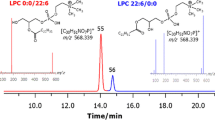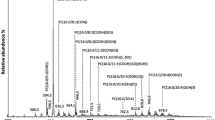Abstract
Dietary phosphatidylinositol (PI) can be synthesized via phospholipase D (PLD)-catalyzed transphosphatidylation of phosphatidylcholine (PC), abundant in soy lecithin, with myo-inositol. However, a generated mixture of phospholipid (PL) classes poses a challenge for analysis. Our current work on Streptomyces PLD engineering requires a robust analytical method for profiling of PI and related PLs derived from the transphosphatidylation reactions. Therefore, we optimized an HPLC-based method with charged aerosol detector (CAD) for PL quantification. PLs were separated on a normal phase silica column by a gradient elution system using two solvents containing chloroform/methanol/1 M formic acid–triethylamine buffer in different ratios. Retention times of the PL standards and LC–MS under identical conditions were used to identity PL classes. PL standards gave linear response in 100- and 10-fold (lyso-PI) concentration range. The method provided a simple, sensitive, repeatable, and precise analysis of PI, PC, phosphatidylethanolamine, phosphatidic acid, and lyso forms of PC and PI. Compared to the similar existing method, introduction of CAD provided a three- to fivefold decrease at the lower end and a two- to fivefold increase at the upper end of the dynamic range. High precision, high sensitivity, and low limits of detection and quantification further underline the benefits of CAD in PL analysis.

Similar content being viewed by others
References
Scholfield C (1981) Composition of soybean lecithin. J Am Oil Chem Soc 58:889–892
Gardocki ME, Jani N, Lopes JM (2005) Phosphatidylinositol biosynthesis: biochemistry and regulation. Biochim Biophys Acta 1735:89–100
Honda K, Enoshima T, Oshikata T, Kamiya K, Hamamura M, Yamaguchi N, Nakamura K, Oguma Y, Fujiwara S, Takabe M, Sono A, Kawasaki T, Nasu M, Otsubo K, Wakigawa K (2009) Toxicity studies of Asahi Kasei PI, purified phosphatidylinositol from soy lecithin. J Toxicol Sci 34:265–280
Zhang N-Y, Kitagawa K, Hattori N, Nakayama Y, Xiong Z-M, Wu B, Liu B, Inagaki C (2007) Soybean-derived phosphatidylinositol inhibits in vivo low concentrations of amyloid β protein-induced degeneration of hippocampal neurons in V337M human tau-expressing mice. Life Sci 80:1971–1976
Shi Y, Azab A, Thompson M, Greenberg M (2006) Inositol phosphates and phosphoinositides in health and disease. In: Majumder AL, Biswas BB (eds) Biology of inositols and phosphoinositides. Springer, New York, pp 265–292
Burgess JW, Neville TA-M, Rouillard P, Harder Z, Beanlands DS, Sparks DL (2005) Phosphatidylinositol increases HDL-C levels in humans. J Lipid Res 46:350–355
Shirouchi B, Nagao K, Inoue N, Furuya K, Koga S, Matsumoto H, Yanagita T (2008) Dietary phosphatidylinositol prevents the development of nonalcoholic fatty liver disease in zucker (fa/fa) rats. J Agric Food Chem 56:2375–2379
Yanagita T, Nagao K (2008) Functional lipids and the prevention of the metabolic syndrome. Asia Pac J Clin Nutr 17:189–191
Jungalwala FB, Turel RJ, Evans JE, McCluer RH (1975) Sensitive analysis of ethanolamine- and serine-containing phosphoglycerides by high-performance liquid chromatography. Biochem J 145:517–526
Carelli A, Brevedan M, Crapiste G (1997) Quantitative determination of phospholipids in sunflower oil. J Am Oil Chem Soc 74:511–514
Mounts T, Abidl S, Rennick K (1992) HPLC analysis of phospholipids by evaporative laser light-scattering detection. J Am Oil Chem Soc 69:438–442
Rombaut R, Camp JV, Dewettinck K (2005) Analysis of phospho- and sphingolipids in dairy products by a new HPLC method. J Dairy Sci 88:482–488
Pelillo M, Ferioli F, Iafelice G, Marconi E, Caboni MF (2010) Characterisation of the phospholipid fraction of hulled and naked tetraploid and hexaploid wheats. J Cereal Sci 51:120–126
Rodriguez-Alcala LM, Fontecha J (2010) Major lipid classes separation of buttermilk, and cows, goats and ewes milk by high performance liquid chromatography with an evaporative light scattering detector focused on the phospholipid fraction. J Chromatogr A 1217:3063–3066
Charlesworth JM (1978) Evaporative analyzer as a mass detector for liquid chromatography. Anal Chem 50:1414–1420
Dixon RW, Peterson DS (2002) Development and testing of a detection method for liquid chromatography based on aerosol charging. Anal Chem 74:2930–2937
Zhou JY, Chaminade P, Gaudin K, Prognon P, Baillet A, Ferrier D (1999) Postcolumn fluorescence as an alternative to evaporative light scattering detection for ceramide analysis with gradient elution in non-aqueous reversed-phase liquid chromatography. J Chromatogr A 859:99–105
Gaudin K, Baillet A, Chaminade P (2004) Adaptation of an evaporative light-scattering detector to micro and capillary liquid chromatography and response assessment. J Chromatogr A 1051:43–51
Cascone A, Eerola S, Ritieni A, Rizzo A (2006) Development of analytical procedures to study changes in the composition of meat phospholipids caused by induced oxidation. J Chromatogr A 1120:211–220
Ramos RG, Libong D, Rakotomanga M, Gaudin K, Loiseau PM, Chaminade P (2008) Comparison between charged aerosol detection and light scattering detection for the analysis of Leishmania membrane phospholipids. J Chromatogr A 1209:88–94
Shaodong J, Lee WJ, Ee JW, Park JH, Kwon SW, Lee J (2010) Comparison of ultraviolet detection, evaporative light scattering detection and charged aerosol detection methods for liquid-chromatographic determination of anti-diabetic drugs. J Pharm Biomed Anal 51:973–978
Damnjanović J, Takahashi R, Suzuki A, Nakano H, Iwasaki Y (2012) Improving thermostability of phosphatidylinositol-synthesizing Streptomyces phospholipase D. Protein Eng Des Sel 25:415–424
Masayama A, Tsukada K, Ikeda C, Nakano H, Iwasaki Y (2009) Isolation of Phospholipase D mutants having phosphatidylinositol-synthesizing activity with positional specificity on myo-inositol. ChemBioChem 10:559–564
Iwasaki Y, Mizumoto Y, Okada T, Yamamoto T, Tsutsumi K, Yamane T (2003) An aqueous suspension system for phospholipase D-mediated synthesis of PS without toxic organic solvent. J Am Oil Chem Soc 80:653–657
Iwasaki Y, Masayama A, Mori A, Ikeda C, Nakano H (2009) Composition analysis of positional isomers of phosphatidylinositol by high-performance liquid chromatography. J Chromatogr A 1216:6077–6080
Shabir GA (2003) Validation of high-performance liquid chromatography methods for pharmaceutical analysis: understanding the differences and similarities between validation requirements of the US Food and Drug Administration, the US Pharmacopeia and the International Conference on Harmonization. J Chromatogr A 987:57–66
Moreau R (2006) The analysis of lipids via HPLC with a charged aerosol detector. Lipids 41:727–734
Acknowledgments
This work was supported in part by a Grant-in-Aid for scientific research C from Japan Society for the Promotion of Science to Y.I. [22560770]. The financial support to J.D. by the Ministry of Education, Culture, Sports, Science and Technology (MEXT) of Japan is deeply appreciated.
Author information
Authors and Affiliations
Corresponding author
Electronic Supplementary Material
Below is the link to the electronic supplementary material.
About this article
Cite this article
Damnjanović, J., Nakano, H. & Iwasaki, Y. Simple and Efficient Profiling of Phospholipids in Phospholipase D-modified Soy Lecithin by HPLC with Charged Aerosol Detection. J Am Oil Chem Soc 90, 951–957 (2013). https://doi.org/10.1007/s11746-013-2236-x
Received:
Revised:
Accepted:
Published:
Issue Date:
DOI: https://doi.org/10.1007/s11746-013-2236-x




